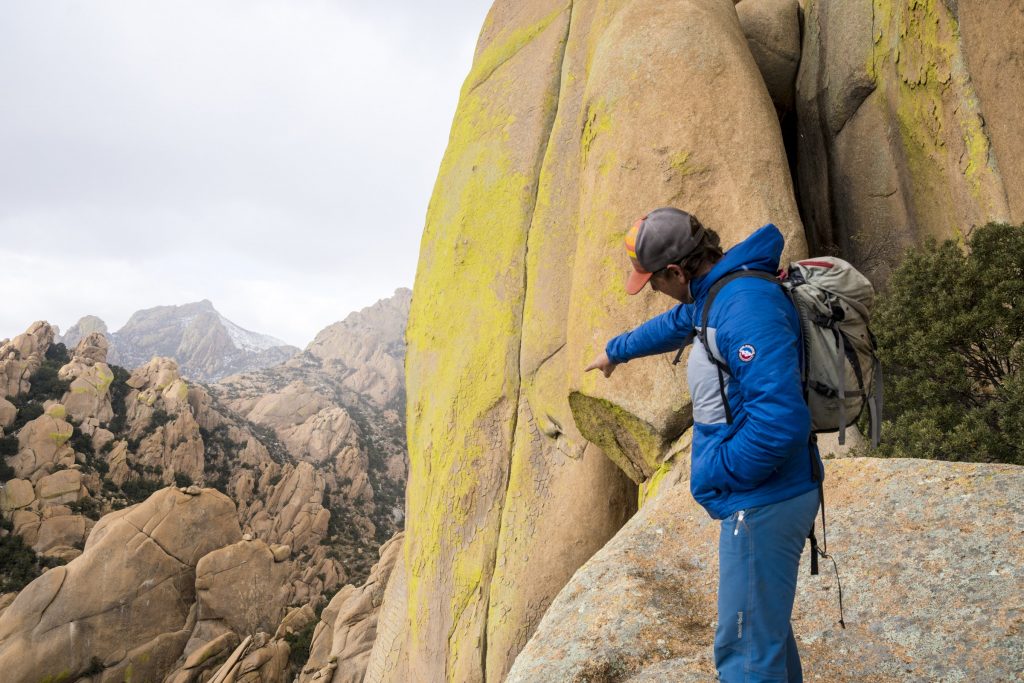Hanging on a protection bolt, on a moderate traverse, unable and unwilling to move; a free climbing failure – I was starting to get grumpy. The wind shrieked across our amphitheater of stone columns and corridors jutting above the green thicket of red trunked madrone trees thrashing in the wind like crazed world cup soccer fans. Dangling several hundred feet up the cliff face, notched perfectly in the tippy top of a mountain pass in the Dragoons of southern Arizona, I suddenly wondered if my climbing rope might actually need to hold me down?

My position was voluntary of course. A long time adventure climber I love visiting Cochise Stronghold. Just finding the trailhead during my first visit in ’88 was challenge enough; yet the combination of prickly desert approaches, striking granite towers covered in vibrant yellow lichen provide for and some of the best moderate multi-pitch routes anywhere. I come back often.
Anna Riling, a friend who wrote a feature for Climbing in 2012, calls Cochise a sanctuary, “…for the hardened, the rare, or the castoff. For the cypress, the coati, and the jaguar. For the Apache, the immigrant, and the climber. For the light, and for the wind.”

Allen Riling, Anna’s husband, was belaying me as I hung there. An overworked solar contractor and cram-in-a-road-trip climber, he definitely considers Cochise his sanctuary. A red-headed, whiskey drinking, Michigan flatlander, he is younger than the age when I paused my own two-decade climbing “road trip.” Still the only thing protecting him from total vagabond is his love and dedication to his family. He has good priorities and we have fun together. When he called last March, I packed the truck, ignored the wintery, windy forecast and headed south.
“It is always windy in Cochise,” Allen quipped.
Included in the Basin and Range province the Dragoon Mountains are deemed “sky islands” – topographically complex jumbles of granite rising sharply along a thriving elevational diversity gradient. This gradient hosts a region of peak global biodiversity, with over 7000 species of plants and animals.

The Chiricahua Apache found strength in this biodiversity long before any pencil pushing scientist started counting. Chief Cochise and his successor Geronimo kept their people free from U.S. Army capture far longer than any other native resistance by melting away into the multi-faceted landscape like ghosts.
An eager tailwind followed us into the Stronghold so we lingered in the lowlands, sport climbing at the Isle of You with stiff, cold fingers. Woken by heavy snow midweek we rested, hiked and watched snow squalls tumble like inebriated pixies. The temperature dropped, the wind freshened and the wise climbers wandered away. Alone, Allen and I wandered stubbornly upwards.

Then for 30 seconds the wind lessened and I scurried across the traverse. Belaying Allen over to join me I looked down the valley and across the wide plains, absorbing, thinking of Cochise:
“I am alone in the world. I want to live in these mountains… I have drunk of the waters of the Dragoon Mountains and they have cooled me, I do not want to leave here.”
— Chief Cochise
About the Author: After his boyhood intro to the outdoors, clad in green wool army pants and horror-movie-like hiking boots built like a Sherman tank, Kennan Harvey became an early proponent of fast-and-light adventure and is very glad that today’s gear advancements manage to outfox even Father Time! He lives in Durango, Colorado with his wife and daughter right above the end of the Colorado Trail.


 English (EUR) | EN
English (EUR) | EN 


